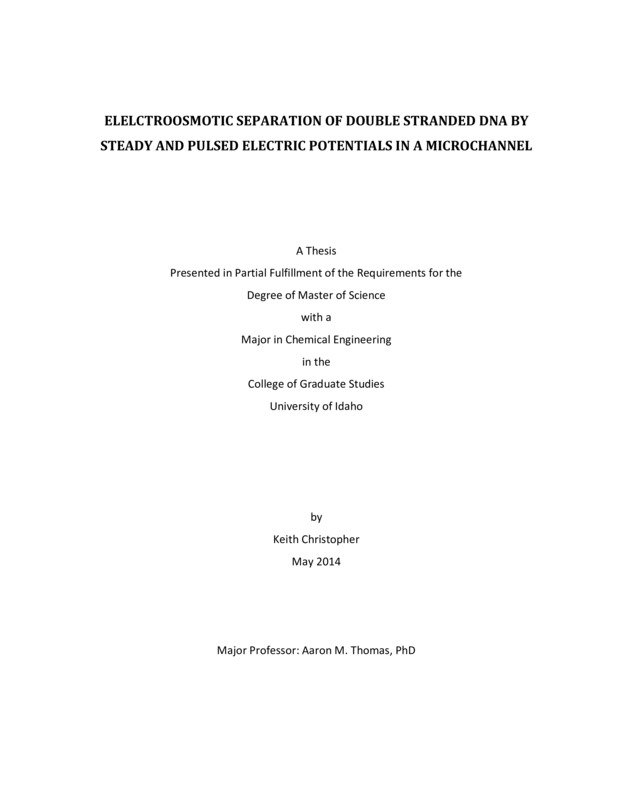ELECTROOSMOTIC SEPARATION OF DOUBLE STRANDED DNA BY STEADY AND PULSED ELECTRIC POTENTIALS IN A MICROCHANNEL
Christopher, Keith George. (2014). ELECTROOSMOTIC SEPARATION OF DOUBLE STRANDED DNA BY STEADY AND PULSED ELECTRIC POTENTIALS IN A MICROCHANNEL. Theses and Dissertations Collection, University of Idaho Library Digital Collections. https://www.lib.uidaho.edu/digital/etd/items/christopher_idaho_0089m_10241.html
- Title:
- ELECTROOSMOTIC SEPARATION OF DOUBLE STRANDED DNA BY STEADY AND PULSED ELECTRIC POTENTIALS IN A MICROCHANNEL
- Author:
- Christopher, Keith George
- Date:
- 2014
- Keywords:
- dsDNA Electroosmosis Lab-on-a-Chip Microcfluidics
- Program:
- Chemical Engineering and Materials Engineering
- Subject Category:
- Chemical engineering
- Abstract:
-
Here, the enhancement of the overall mass transfer and separation of double stranded DNA (dsDNA) in a microchannel using steady and pulsatile flow is studied... The degree of separation was seen to increase with oscillatory flow as compared to steady conditions. It was also observed that the separation improved with increasing oscillation amplitude until reaching a certain critical point when the oscillations were large enough to begin promoting mixing. The study achieves the initial goal of proof-of-concept of microscale separation through electroosmotic flows and furthers the effort of building a handheld `lab-on-a-chip' device that could be used to rapidly analyze a variety of biomolecules.
Microchannel castings were made using polydimethyl siloxane (PDMS). A mixture of 10mer and 50mer dsDNA along with another mixture of 10mer and 100mer dsDNA were used to visualize the separations using epifluorescence microscopy. The observations were characterized using a spectrophotometer which utilized a program known as Avasoft 8. The peak-to-peak separation distance between the dsDNA species demonstrated a dependence on the microchannel geometry, the electrical double layer, and the amplitude of the oscillations. Numerical velocity profiles and concentration tracking plots were generated with COMSOL Multiphysics to provide further insight and understanding of the dependency of these characteristics on the separation process.
- Description:
- masters, M.S., Chemical Engineering and Materials Engineering -- University of Idaho - College of Graduate Studies, 2014
- Major Professor:
- Aston, Eric
- Committee:
- Thomas, Aaron M; Admassu, Wudneh
- Defense Date:
- 2014
- Identifier:
- Christopher_idaho_0089M_10241
- Type:
- Text
- Format Original:
- Format:
- application/pdf
- Rights:
- In Copyright - Educational Use Permitted. For more information, please contact University of Idaho Library Special Collections and Archives Department at libspec@uidaho.edu.
- Standardized Rights:
- http://rightsstatements.org/vocab/InC-EDU/1.0/

